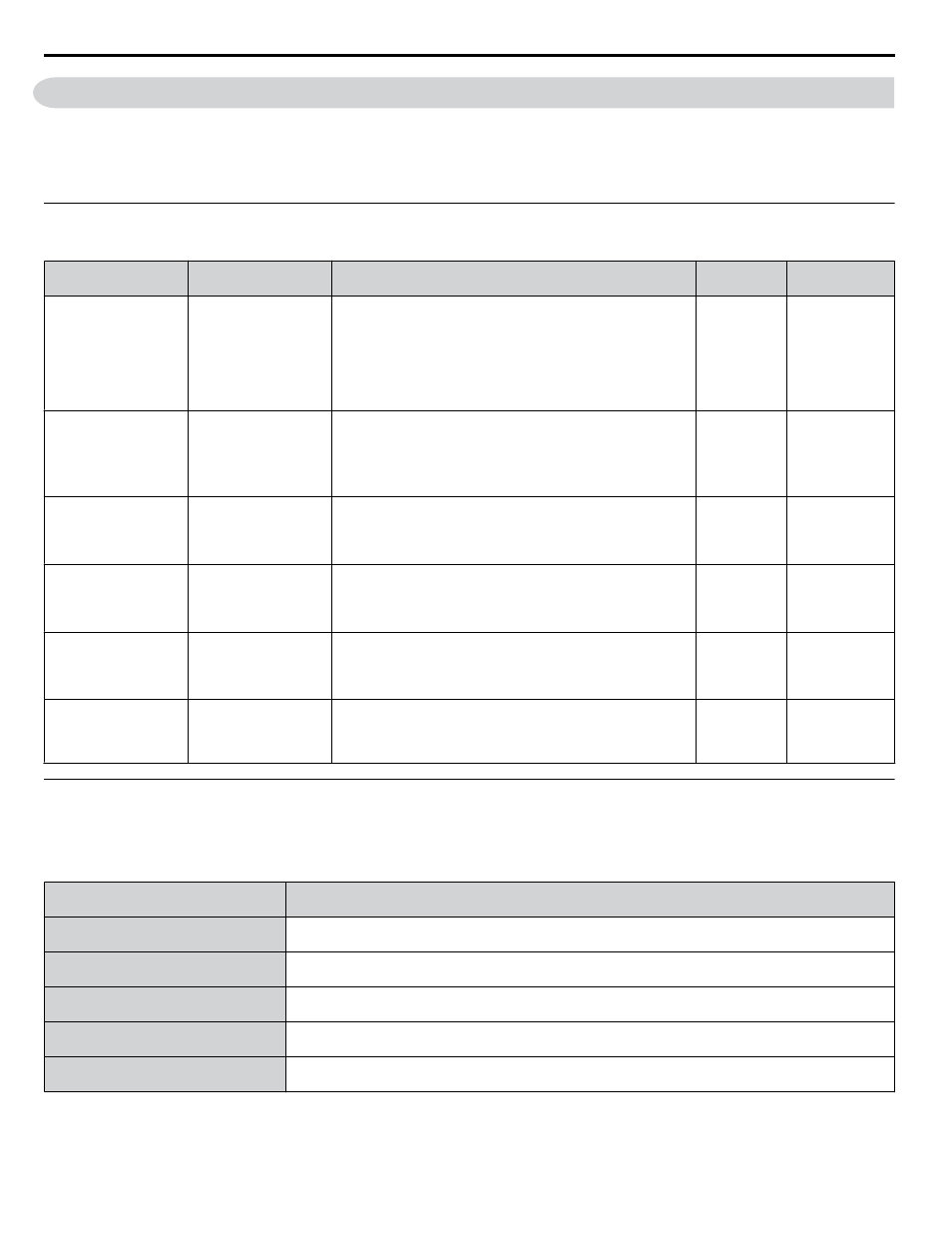Motor performance fine-tuning, Fine-tuning v/f control, 2 motor performance fine-tuning – Yaskawa AC Drive-P1000 Industrial Fan User Manual
Page 290

6.2 Motor Performance Fine-Tuning
This section offers helpful information for counteracting oscillation, hunting, and other problems that occur while performing
a trial run. Refer to the section below that corresponds to the motor control method used.
Note:
This section describes commonly edited parameters that may be set incorrectly. Consult Yaskawa for more information on detailed settings
and for fine-tuning the drive.
u
Fine-Tuning V/f Control
Table 6.1 Parameters for Fine-Tuning Performance in V/f Control
Problem
Parameter No.
Corrective Action
Default
Suggested
Setting
Motor hunting and
oscillation at speeds
between 10 and 40 Hz
Hunting Prevention
Gain (n1-02)
• Reduce the setting if insufficient motor torque relative to the
size of the load causes hunting.
• Increase the setting when motor hunting and oscillation occur
with a light load.
• Reduce the setting if hunting occurs when using a motor with
a relatively low inductance, such as a high-frequency motor or
a motor with a larger frame size.
1.00
0.10 to 2.00
• Motor noise
• Motor hunting and
oscillation at speeds
up to 40 Hz
Carrier Frequency
Selection (C6-02)
• Increase the carrier frequency If the motor noise is too loud.
• Lower the carrier frequency when motor hunting and
oscillation occur at speeds up to 40 Hz.
• The default setting for the carrier frequency depends on the
drive capacity (o2-04).
1 (2 kHz)
1 to max. setting
• Poor torque or speed
response
• Motor hunting and
oscillation
Torque Compensation
Primary Delay Time
(C4-02)
• Reduce the setting if motor torque and speed response are too
slow.
• Increase the setting if motor hunting and oscillation occur.
200 ms
100 to 1000 ms
• Poor motor torque at
speeds below 10 Hz
• Motor hunting and
oscillation
Torque Compensation
Gain (C4-01)
• Increase the setting if motor torque is insufficient at speeds
below 10 Hz.
• Reduce the setting if motor hunting and oscillation with a
relatively light load.
1.00
0.50 to 1.50
• Poor motor torque at
low speeds
• Motor instability at
motor start
Mid Output Voltage A
(E1-08)
Minimum Output
Voltage (E1-10)
• Increase the setting if motor torque is insufficient at speeds
below 10 Hz.
• Reduce the setting If motor instability occurs at motor start.
Depends on
o2-04, Drive
Model
Selection
Default setting
±5 V
Poor speed precision
(V/f control)
Slip Compensation Gain
(C3-01)
Set the motor-rated current (E2-01), motor-rated slip (E2-02),
and motor no-load current (E2-03), then adjust the slip
compensation gain (C3-01).
0.0
(no slip
compen-
sation)
0.5 to 1.5
u
Parameters to Minimize Motor Hunting and Oscillation
In addition to the parameters discussed in table
indirectly affect motor hunting and
oscillation.
Table 6.2 Parameters that Affect Control Performance in Applications
Name
(Parameter No.)
Application
Dwell Function
(b6-01 through b6-04)
Prevents motor speed loss by maintaining the output frequency when working with heavy loads or when there
is powerful backlash on the machine side.
Accel/Decel Time
(C1-01 through C1-11)
Adjusting accel and decel times will affect the torque presented to the motor during acceleration or
deceleration.
S-Curve Characteristics
(C2-01 through C2-04)
Prevents shock at the beginning and end of acceleration and deceleration.
Jump Frequency
(d3-01 through d3-04)
Skips over the resonant frequencies of connected machinery.
Analog Filter Time Constant
(H3-13)
Prevents fluctuation in the analog input signal due to noise.
6.2 Motor Performance Fine-Tuning
290
YASKAWA SIEP YAIP1U 01B AC Drive - P1000 Technical Manual
